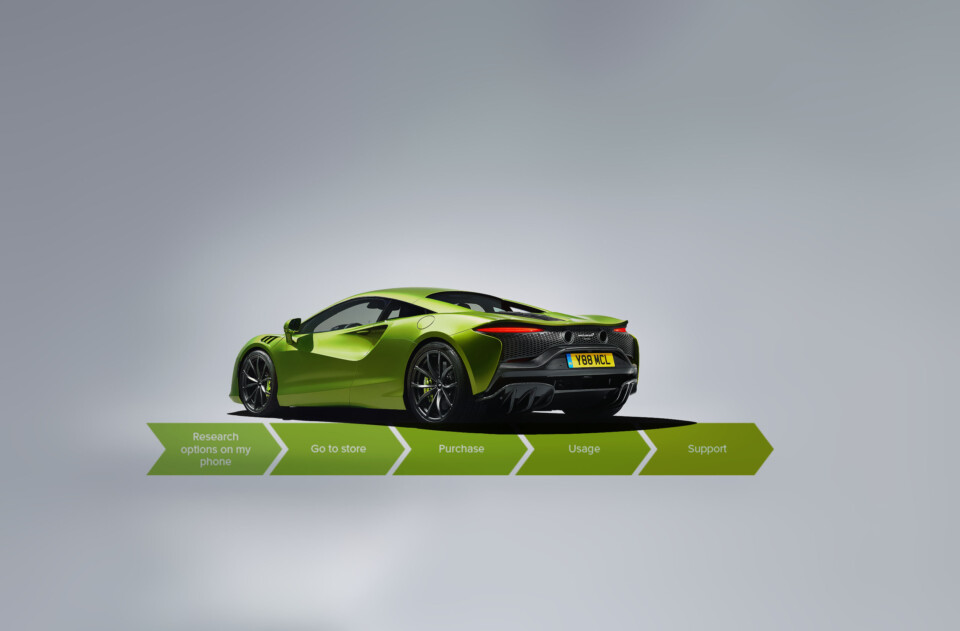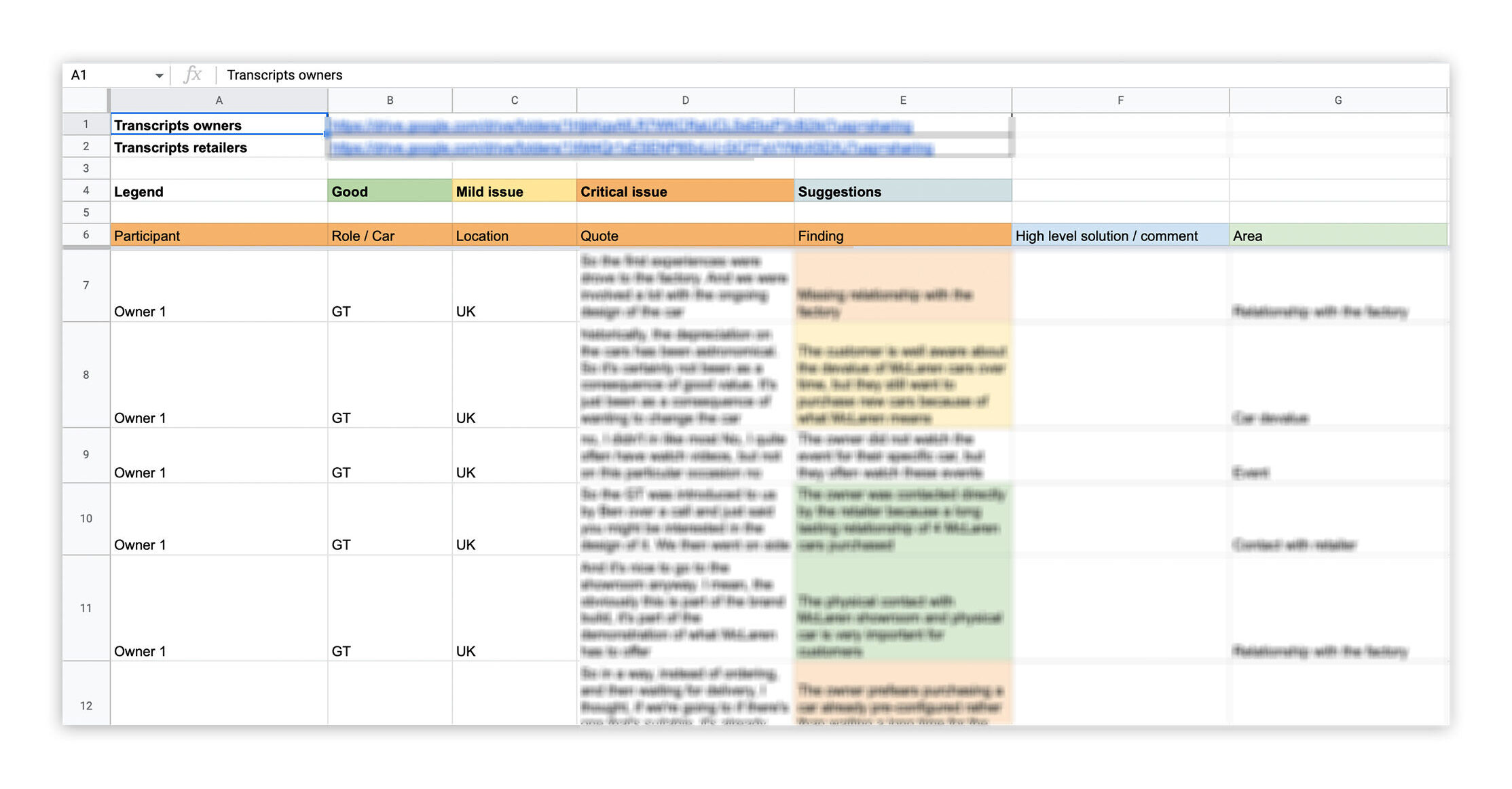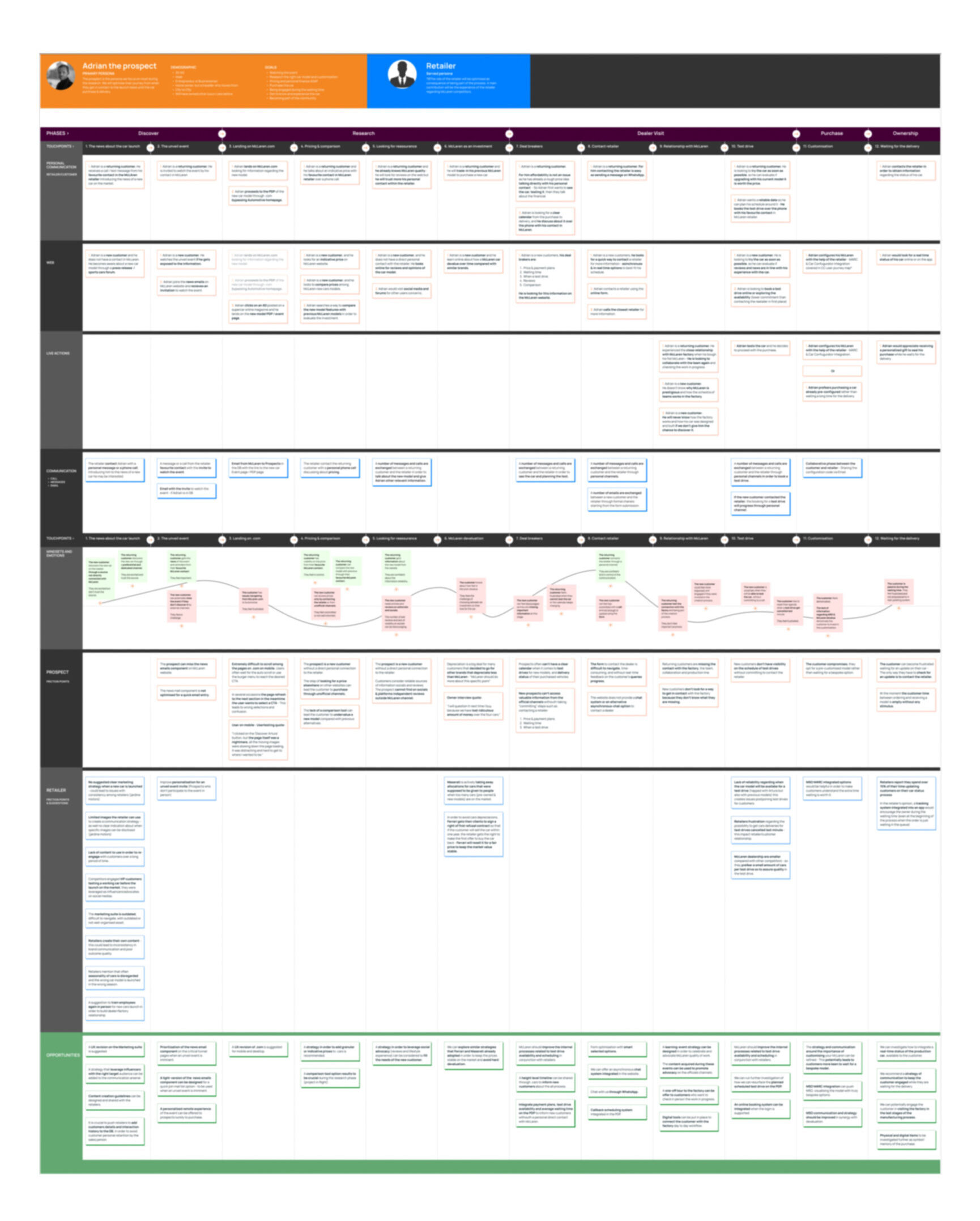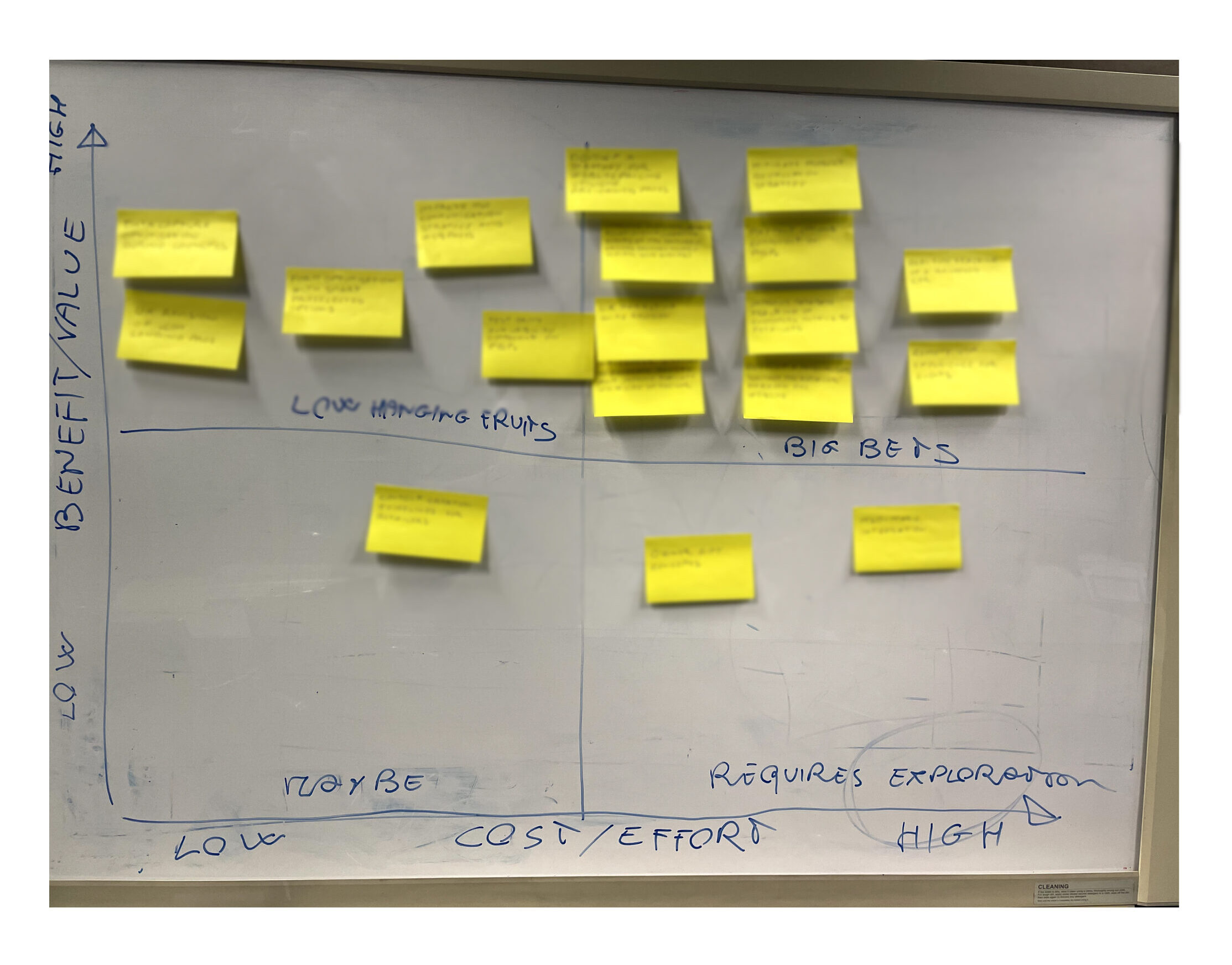McLaren – Car Purchase Process
Car Purchase Process
McLaren Automotive
Executive summary
The project focused on optimising McLaren Automotive’s car purchase process for the re-launch of a disrupted car model. Through customer journey mapping and a triangulated research approach—including desk research, user testing, semi-structured interviews, and competitive analysis—we identified and addressed key friction points in both online and offline experiences.
Deliverables included “as-is” and “to-be” customer journey maps, detailing actionable improvements to usability, website functionality, retailer tools, and larger organisational processes. An effort-mapping workshop was conducted to prioritise enhancements based on user value and ROI.
As a result of these optimisations, we achieved a 25% increase in Customer Satisfaction Score (CSAT) and an 18% rise in Sales Conversion Rate, demonstrating the meaningful enhancements made to the customer experience.
My role
User testing, Semi-structured interviews, Data analysis, Customer journey map, SME Workshop Facilitator
Timeframe: 4 weeks (Before effort mapping)
Background
McLaren is a British automotive manufacturer that specializes in producing high-performance sports cars and supercars.
McLaren produces a range of sports cars and supercars for both the road and the track, including the 720S, the 765LT, and the Artura. The company also offers a range of customization options and limited-edition models for collectors and enthusiasts.
The team
I was involved in this project at MediaMonks, a company specializing in digital production and offering a broad spectrum of services, such as video production, social media marketing, website design and development, and strategic planning.
As a team member, I was responsible for designing and executing the project plan, including defining the tasks and timelines. I collaborated closely with several UX colleagues, who supported me in various phases of the project, especially during the interview research phase where their assistance with note-taking was invaluable. Together, we created a comprehensive table of opportunities that informed the direction of the project.
UX plan
To achieve the best result we suggested identifying friction points through a triangulation of research methods including:
- Desk research
- User testing
- Short semi-structured interviews
- Competitive review
We then suggested mitigations for each identified friction point, effort mapping each opportunity in relation to the ROI.
Understanding the problem
In the initial meeting with the company’s stakeholders and marketing manager, we looked into problems and feedback from customers about the buying process. Although our project didn’t have a service design approach, we also examined concerns raised by company employees to improve internal processes.
This meeting helped us assess the client’s expectations for the project’s deliverables and whether a customer journey map would be appropriate for this purpose.
Agree on personas and touchpoints
The initial step of the project was to identify the key personas involved in the customer journey of purchasing a car model, in consultation with stakeholders. After deliberation, it was agreed that the primary persona would be the Prospect, who represents potential buyers who may be interested in purchasing the car. The primary persona included the current Owner, as they often demonstrate a continued interest in purchasing newer models from the same brand.
Additionally, the team recognized the importance of considering the supporting persona of the Retailer, who plays a critical role in the customer journey by facilitating the purchase and providing post-sale support.
The next critical phase of the project involved developing a preliminary customer journey, including touchpoints and areas of interest. This was done in collaboration with the client to ensure that the proposed customer journey aligned with their goals and expectations.
The preliminary customer journey was a rough draft that was open to revision and refinement based on client feedback.
Desk research outcome
During the initial phase of research, we conducted a thorough investigation of all the available documentation related to McLaren automotive in both MediaMonks and the client’s archives. Desk research is particularly valuable when previous research is available because it is a quick and inexpensive task that can save time and prevent duplication of efforts.
Our investigation yielded several key findings:
- Personas: We found primary and secondary personas from previous research, but the Retailer persona needed further development, which we addressed with the help of marketing (proto-persona sufficed the scope).
- Retailers’ insight: We gained valuable insights from previous interviews with 5 retailers about implementing a car configurator tool in their salons.
- User testing: We also used user testing tasks from previous projects that were performed on website pages and forms.
- Competitive research: We investigated previous competitive research we conducted on the McLaren automotive website homepage and product detail pages.
We only selected research documentation relevant to the touchpoints we intended to cover on the customer journey map. Using this research, we began creating a table of opportunities that we continued to update as we conducted further research.
User testing the online journey
To evaluate the entire customer’s journey, from customers being informed about a new car launch, to finalizing the purchase, we employed various research techniques that corresponded to the relevant channels. Specifically, we user-tested with the Uertesting platform the following steps of the online journey:
- The point at which users are exposed to news about the new car launch.
- Organic searches for the new car model, as research suggests that most users prefer this method of gathering information instead of engaging with advertising.
- Progression through various pages on McLaren automotive website, up to landing on the product detail page of the model.
- Completion of a contact form.
User testing steps and preparation
User testing is a process that requires multiple steps to ensure the accurate and efficient completion of tasks. When using a testing platform for user testing, the responsibility of handling privacy and data protection related to participants is taken care of by the platform provider, eliminating the need for documentation.
- To start the user testing process, we set research objectives that guide the tasks we ask participants to perform and inform our data analysis. We focused on testing Findability, Utility, Credibility, Usability, and User expectation throughout the journey.
- Next, we carefully selected participants who match the brand’s target audience and used screening questions to ensure specificity. For instance, for McLaren, we sought out participants who are genuinely interested in supercars.
- We then wrote a test script that guides participants through all the touchpoints we want to test. Rather than asking for their opinions, we focused on asking them to complete tasks and observe their outcomes. We also asked them to share their expectations before each task and checked if those expectations aligned with the outcome after completing the task.
- After creating a prototype, we set up the test. Since most of the journey was already available on the McLaren website, we only needed to replicate the advertising part of the journey.
- Before launching the test with 5 participants on mobile and 5 on desktop, we ran a pilot test to catch any potential issues in the early stages. This is always recommended to ensure a smoother and more accurate testing process.
Browse the user testing script here: User Testing Script
User testing outcome
After conducting the user testing, we analyzed the results and presented them in an organized table of opportunities. The table is divided by device type, specific touchpoints in the journey, and the severity of the friction points.
Our analysis revealed usability issues, as well as instances where important information was missing, hindering participants’ ability to make informed decisions before purchasing a car model.
We began addressing these friction points by brainstorming potential mitigations for each one.
If you would like to view how the table of opportunities was organised, you can find it in the Car launch – table of opportunities (confidential data has been removed).
Semi-structured interviews
To study the offline aspect of the customer’s journey, we interviewed a group of McLaren car owners. Our focus was on examining the various touchpoints that involve in-person interactions during the purchasing process:
- Interactions with the retailer
- Financial searches before the purchase
- Customisation of the vehicle
- Updates and waiting time after the purchase
To ensure a representative sample, McLaren provided us with a balanced group of owners, and we conducted the interviews remotely through a video platform. We obtained recorded verbal consent from each participant to record the interviews, which we transcribed before deleting the video.
Browse the interview discussion guide at the following link: Owners discussion guide
Competitive analysis via proxy
Conducting a competitive analysis is essential to improve the purchasing process in a given market. However, it can be challenging to perform this analysis for high-end products, especially during a launch.
To overcome this challenge, we chose to gather information about our competitors by interviewing a select group of subject matter experts, namely McLaren retailers. We conducted several interviews with them, with a focus on their knowledge of how competitors’ processes and performances compare with those of McLaren.
The insights we gathered from these interviews were excellent and provided valuable information for improving our purchasing process.
Browse the interview discussion guide at the following link: Dealers discussion guide
Learning
Sometimes, when the situation of your project doesn’t allow for the usual use of UX tools, you need to be creative and come up with new ways to approach the problem.
In this particular project, we were unable to conduct research on our competitors, which is typically a crucial step. To compensate for this, we decided to gather information from dealers who have knowledge about other supercar brands. Fortunately, we were able to obtain a wealth of valuable insights through this approach.
Customer journey map
We used the data obtained from our research triangulation to create an “as-is” customer journey map, which helped us better understand the information we had collected.
At the start of the project, we established specific phases and touchpoints with the client. We used these to categorize the insights we gathered into different channels that corresponded to the actions taken by the two personas involved in the journey: the prospect and the retailer. These channels included various communication methods such as personal communication, web interactions, live actions, and other communication channels.
Additionally, we included in the map the emotional curve that highlighted the user’s emotional states, and friction points that we had identified during our research.
Once we had defined the as-is customer journey map, we focused on finding solutions for each friction point to enhance the overall customer experience. This led us to create a “to-be” customer journey map, which reflects the improved journey with the identified solutions in place.
See the customer journey map below (confidential data has been removed).
Effort mapping opportunities
As we worked on designing the “to-be” customer journey map, we discovered several areas where McLaren could enhance their purchase process. These improvements encompassed not only usability enhancements on the website, forms, and retailers’ digital tools, but also a rethinking of large-scale processes.
To prioritize these enhancements, we organized an effort-mapping workshop with the client’s subject matter experts. The workshop involved McLaren’s marketing, development, digital management, and MediaMonks UX team, all working together to determine the user value of each proposed improvement.
After the workshop, we were able to generate a prioritized list of enhancements that included high-level quotes and the potential impact on users.
Final thoughts
This project underscores the importance of a user-focused, research-driven methodology in enhancing complex customer journeys. By addressing key friction points and prioritising impactful improvements, McLaren is well-equipped to deliver a seamless purchase experience that meets customer expectations and supports the successful re-launch of their car model.





